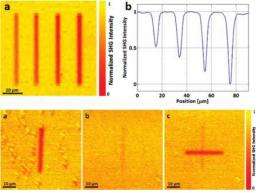October 13, 2010 feature
Scientists propose 'hidden' 3D optical data storage technique

(PhysOrg.com) -- By using a laser to reversibly combine and separate molecules, scientists have demonstrated a new optical data storage technique. Because the data can be read by only one kind of imaging technique (second-harmonic generation-assisted imaging), the new method could be used for hidden 3D data storage.
The scientists, Konstantinos Iliopoulos and coauthors from the University of Angers, France, have published their study in a recent issue of the Journal of the American Chemical Society.
The researchers designed a new class of nonlinear optical (NLO) coumarin-based polymers that can be reversibly transformed into dimers (which are large molecules made of two identical smaller molecules) under irradiation by different wavelengths of light. Whereas wavelengths greater than 300 nm can produce dimers, wavelengths less than 280 nm do the reverse, separating each dimer into two individual molecules. Since each type of molecule is electronically and structurally very different, optically controlling this process can provide the basis for writing, reading, erasing, and rewriting data.
“The most important issue is the conjugation of several aspects in one system,” coauthor Denis Gindre of the University of Angers told PhysOrg.com. “First, a high density of data storage; second, re-writability; and third, the fact that these issues can only be addressed by a non-linear technique (and are non-detectable by linear techniques).”
To demonstrate the possibility of writing data in this way, the scientists irradiated a coumarin-based polymer with a laser with a wavelength of 700 nm (for a two-photon process at 350 nm). The laser created a photodimerization reaction of the coumarin molecules, changing the polymer into a dimer form. By controlling the irradiation, the scientists demonstrated the recording of lines and dots.
The recorded data could be read by a method called second-harmonic generation (SHG)-assisted imaging, in which photons interacting with the NLO material combine to form photons with twice the energy. The level of SHG signals is significantly lower than the unwritten background area, resulting in two distinct logical levels. No loss of recorded bits along the reading process was observed because the UV light generated by SHG is not absorbed by the molecules, avoiding the erasing of information by further chemical reaction.
Finally, the scientists showed that the data could be erased and rewritten in the same area. To erase, the written polymer was exposed to a UV light with a wavelength of less than 280 nm, which converted the dimer polymer back into its original form. After using SHG imaging to confirm that the data was erased, the scientists repeated the writing process with the longer-wavelength laser.
This novel approach to optical data storage has the potential to provide an efficient, high-capacity data storage method, the scientists note. Also, because the reading process can be carried out only by SHG imaging, the technique could be used for the sensitive field of hidden 3D data storage.
“This technique can, in principle, be applied to a bulk 3D material,” said coauthor Marc Sallé of the University of Angers. “With such a concept, it is impossible to read the written information with conventional linear techniques like optical microscopy, polarization microscopy, atomic force microscopy, and so on. This is why the term 'hidden' was used. One potential application is, for instance, undetectable marking to detect fakes or counterfeits.”
More information: Konstantinos Iliopoulos, et al. “Reversible Two-Photon Optical Data Storage in Coumarin-Based Copolymers.” Journal of the American Chemical Society, Article ASAP. DOI: 10.1021/ja1047285
Copyright 2010 PhysOrg.com.
All rights reserved. This material may not be published, broadcast, rewritten or redistributed in whole or part without the express written permission of PhysOrg.com.















